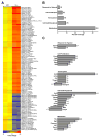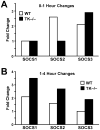Ron receptor-dependent gene regulation in a mouse model of endotoxin-induced acute liver failure
- PMID: 22893465
- PMCID: PMC4102423
- DOI: 10.1016/s1499-3872(12)60196-9
Ron receptor-dependent gene regulation in a mouse model of endotoxin-induced acute liver failure
Abstract
Background: Prior experimentation has shown that loss of the tyrosine kinase (TK) signaling domain of the Ron receptor leads to marked hepatocyte protection in a model of lipopolysaccharide-induced acute liver failure (ALF) in D-galactosamine (GalN)-sensitized mice. The aim of this study was to identify the role of Ron in the regulation of hepatic gene expression.
Methods: Microarray analyses were performed on liver RNA isolated sequentially from wild-type (WT) and TK-/- mice during the progression of ALF. Gene array data were validated using Western and immunohistochemistry analyses as well as with ex vivo culture systems.
Results: At baseline, 101 genes were differentially expressed between WT and TK-/- livers, which regulate processes involved in hypoxia, proliferation, apoptosis and metabolism. One hour after ALF induction, WT livers exhibited increased cytokine expression compared to TK-/- livers, and after 4 hours, an induction of suppressor of cytokine signaling (SOCS) genes as well as JAK-STAT pathway activation were prominent in TK-/- livers compared to controls.
Conclusion: Our studies suggest a novel hepato-protective mechanism in Ron TK-/- mice wherein increased and sustained SOCS production and JAK-STAT activation in the hepatocyte may inhibit the destructive proinflammatory milieu and promote survival factors which blunt hepatic death and the ensuing development of ALF.
Conflict of interest statement
Figures






Similar articles
-
Ron receptor-dependent gene regulation of Kupffer cells during endotoxemia.Hepatobiliary Pancreat Dis Int. 2014 Jun;13(3):281-92. doi: 10.1016/s1499-3872(14)60254-x. Hepatobiliary Pancreat Dis Int. 2014. PMID: 24919612 Free PMC article.
-
Deletion of the Ron receptor tyrosine kinase domain in mice provides protection from endotoxin-induced acute liver failure.Hepatology. 2002 Nov;36(5):1053-60. doi: 10.1053/jhep.2002.36822. Hepatology. 2002. PMID: 12395314
-
Ron receptor regulates Kupffer cell-dependent cytokine production and hepatocyte survival following endotoxin exposure in mice.Hepatology. 2011 May;53(5):1618-28. doi: 10.1002/hep.24239. Hepatology. 2011. PMID: 21520175 Free PMC article.
-
The signal transduction mediated by erythropoietin and proinflammatory cytokines in the JAK/STAT pathway in the children with cerebral palsy.Brain Dev. 2009 Mar;31(3):200-7. doi: 10.1016/j.braindev.2008.06.011. Epub 2008 Aug 19. Brain Dev. 2009. PMID: 18715729 Review.
-
Suppressors of cytokine signaling (SOCS) proteins and JAK/STAT pathways: regulation of T-cell inflammation by SOCS1 and SOCS3.Arterioscler Thromb Vasc Biol. 2011 May;31(5):980-5. doi: 10.1161/ATVBAHA.110.207464. Arterioscler Thromb Vasc Biol. 2011. PMID: 21508344 Review.
Cited by
-
LPS pretreatment ameliorates D-galactosamine/lipopolysaccharide-induced acute liver failure in rat.Int J Clin Exp Pathol. 2014 Oct 15;7(11):7399-408. eCollection 2014. Int J Clin Exp Pathol. 2014. PMID: 25550775 Free PMC article.
-
Ron receptor-dependent gene regulation of Kupffer cells during endotoxemia.Hepatobiliary Pancreat Dis Int. 2014 Jun;13(3):281-92. doi: 10.1016/s1499-3872(14)60254-x. Hepatobiliary Pancreat Dis Int. 2014. PMID: 24919612 Free PMC article.
-
An Introduction and Overview of RON Receptor Tyrosine Kinase Signaling.Genes (Basel). 2023 Feb 17;14(2):517. doi: 10.3390/genes14020517. Genes (Basel). 2023. PMID: 36833444 Free PMC article. Review.
References
-
- Stravitz RT, Kramer DJ. Management of acute liver failure. Nat Rev Gastroenterol Hepatol. 2009;6:542–553. - PubMed
-
- Igonin AA, Armstrong VW, Shipkova M, Lazareva NB, Kukes VG, Oellerich M. Circulating cytokines as markers of systemic inflammatory response in severe community-acquired pneumonia. Clin Biochem. 2004;37:204–209. - PubMed
-
- Hishinuma I, Nagakawa J, Hirota K, Miyamoto K, Tsukidate K, Yamanaka T, et al. Involvement of tumor necrosis factor-alpha in development of hepatic injury in galactosamine-sensitized mice. Hepatology. 1990;12:1187–1191. - PubMed
-
- Jirillo E, Caccavo D, Magrone T, Piccigallo E, Amati L, Lembo A, et al. The role of the liver in the response to LPS: experimental and clinical findings. J Endotoxin Res. 2002;8:319–327. - PubMed
Publication types
MeSH terms
Substances
Grants and funding
LinkOut - more resources
Full Text Sources

